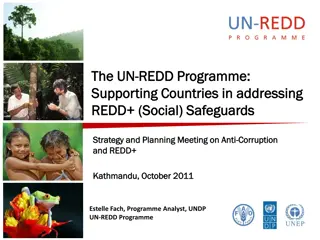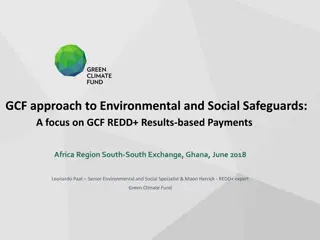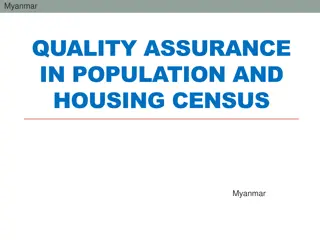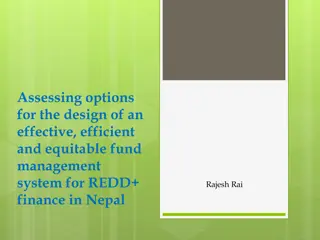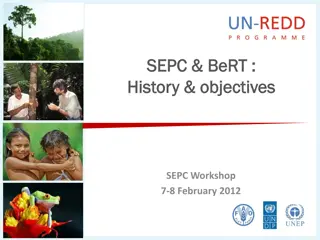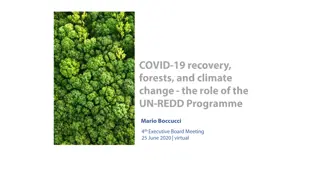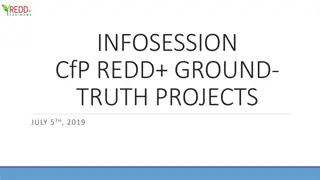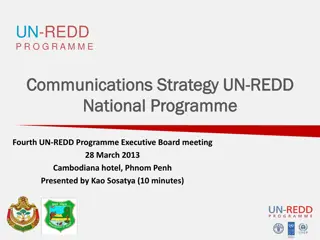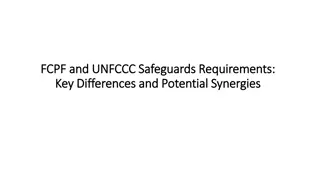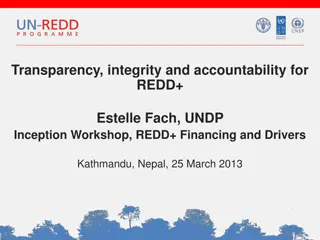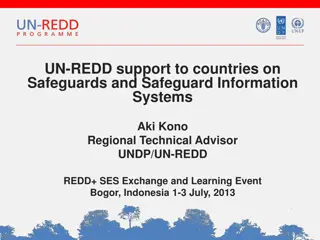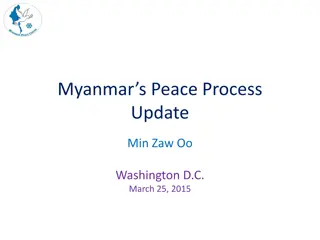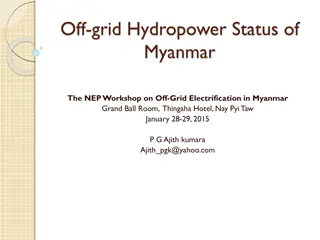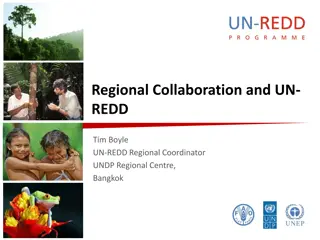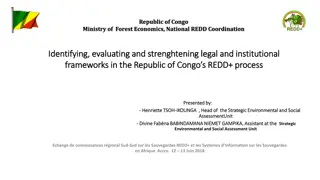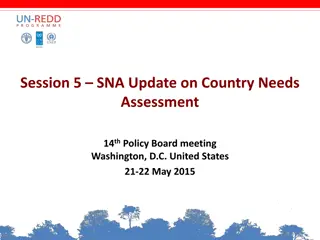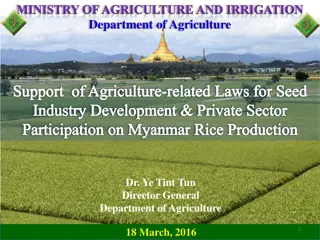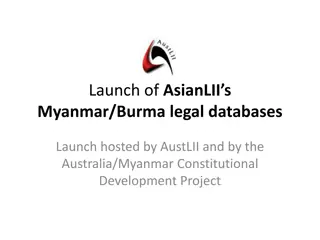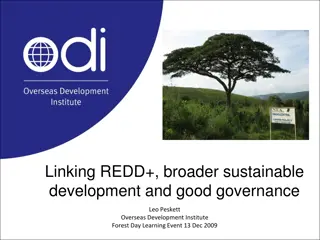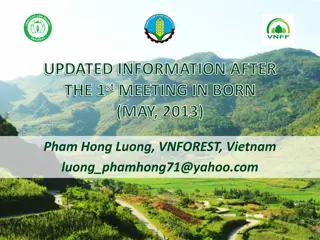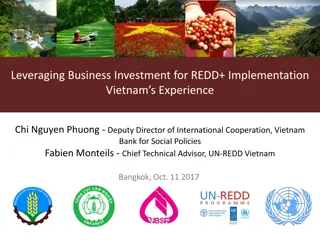Promoting Green Development Through REDD+ in Myanmar
Myanmar, with its vast forest resources, faces challenges of high deforestation rates and forest degradation. The REDD+ Programme in Myanmar aims to tackle these issues through a comprehensive strategy involving multiple stakeholders. The program focuses on sustainable forest management, community engagement, and achieving targets set in the country's NDC. By promoting green development practices, Myanmar seeks to protect its valuable forests and enhance rural livelihoods.
Download Presentation

Please find below an Image/Link to download the presentation.
The content on the website is provided AS IS for your information and personal use only. It may not be sold, licensed, or shared on other websites without obtaining consent from the author. Download presentation by click this link. If you encounter any issues during the download, it is possible that the publisher has removed the file from their server.
E N D
Presentation Transcript
REDD+ supporting Green Development in Myanmar India Myanmar By Khin Hnin Myint National Programme Manager UN-REDD Programme Myanmar Date: November 16th, 2017 COP23 SIDE EVENT REDD+ Programme Myanmar
Introduction to Myanmar Myanmar is the largest country in mainland S.E Asia and ranks 4th in Asia in terms of total forest area (after China, Indonesia, India; 30.6 million ha ) Enormous range of forest types from sub-alpine in northern Kachin to humid tropical lowland forests in the south Population (52 million) is still largely rural (65%) with many ethnic groups Deforestation rate remains high (nearly 400,000ha/year), largely due to agricultural development Forest degradation also significant (biomass fuels) Mount Khakaborazi in northern Kachin Putao in Myanmar Humid lowland forest in Mergui Archipelago, Tanintharyi
Overview of the REDD+ Programme Myanmar REDD+ Readiness Roadmap developed in 2013; UN-REDD support to implementation of the Roadmap began in 2015; and expected to continue up to 2020; Draft National REDD+ Strategy undergoing broad consultation (across 7 Ministries and with CSOs; sub- national consultations in all states/regions underway; public comments period early in 2018; Initial FRL expected to be submitted before January 8th, 2018; and Process overseen by National REDD+ Taskforce, reporting to Central Committee for National Environmental Conservation and Climate Change (Minister-level), and supported by three Technical Working Groups. The 1stTaskforce meeting TWG Meetings of Stakeholders Engagement and Safeguards, & Drivers and Strategy for REDD+
REDD+ and the NDC The Mitigation componentof Myanmar s (I)NDC encompasses two sectors: Forestry, and Energy; The Forestry target is that, by 2030, Myanmar s Reserved Forests and Protected Public Forests amount to 30% of total national land area; and Protected Areas cover 10% of total national land area, as set out in the 30-Year National Forestry Master Plan (2001-30); The Energy targets include the use of at least 30% renewable sources for rural electrification; and to distribute approx. 260,000 cookstoves between 2016-2031; and The Adaptation component identifies 4 priority sectors: (1) agricultural resilience, including forest protection; (2) public health protection/water resource management; (3) coastal zone protection; and (4) energy & industry sectors, and biodiversity preservation. Putao in Myanmar
Main SDGs related to REDD+ in Myanmar For many of Myanmar s poor (26%), living in rural areas, forests are a source of income. Through REDD+ their capacity to increase incomes from the forests will be developed Forests are a direct source of food but also support the productivity of agro- ecosystems Revitalizing forest industries, including the Myanmar Timber Enterprise, can provide work and contribute to economic growth Many women are leaders of community forest groups, in contrast to the gender situation in most of the rest of society Many rural communities are marginalized; empowering them through REDD+ can reduce inequality As noted in the previous slide, forests are central to Myanmar s (I)NDC The underlying causes of threats to forests are often the same as those leading to conflict, including weak institutions. This is central to Myanmar s efforts to resolve internal conflicts REDD+ will work to protect, restore and enhance sustainable use of terrestrial ecosystems, sustainably manage forests, combat desertification, and halt and reverse land degradation and halt biodiversity loss
REDD+ in Green Development Strategy Myanmar is well-advanced in developing a comprehensive policy framework in support of green development. This consists of a Green Economy Policy Framework , which encompasses: Environmental Policy Climate Policy Land Use Policy Waste Management Policy Hkakaborazi Landscape s World Heritage journey Information needs for the Green Economy Policy Framework will be supported through the Myanmar OneMap Initiative The Mergui's mangrove forests Zwekabin mountain in Kayin state
Results/progress/achievements Myanmar has made dramatic advances from the incomplete and uncoordinated policy environment of a decade ago. Policy development is now much more inclusive for example the Land Use Policy went through multiple rounds of extensive public consultation and inputs. The current government banned all logging for one year and in parts of Bago-Yoma for 10 years; annual allowable cuts reduced to sustainable levels and State Counsellor, Daw Aung San Suu Kyi, has called for no more forest conversion. Forests in Myanmar. Photo: REDD+ Myanmar Despite starting on REDD+ readiness later than many countries, Myanmar is rapidly catching up, and is looking towards RBP s by 2020. Forests in Myanmar. Photo: REDD+ Myanmar
Key Lessons REDD+ can be a catalyst not only for more sustainable forest management, but also for increased democratization of governance structures and conflict resolution a very important issue in Myanmar. The REDD+ Readiness process in Myanmar has contributed to empowerment of many stakeholder groups, including those that have been historically marginalized (e.g., women, Indigenous Peoples). Addressing indirect drivers of deforestation and forest degradation is, first and foremost, a policy issue the policy environment needs to support on-the-ground actions. Myanmar stands on the brink of major progress in reducing deforestation and forest degradation, but needs additional international support. A recent exchange with Brazil has shown the value of international cooperation. Mergui Islands by Micheal Capaldi
Thank You Ms. Khin Hnin Myint National Programme Manager UN-REDD National Programme Email: khin.hnin.myint@undp.org Learn more about us: Website: http://www.myanmar-redd.org/ Follow us: REDD+ Programme in Myanmar


